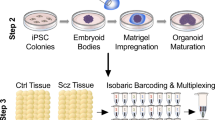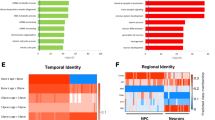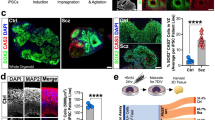Abstract
Proteins involved in the Alzheimer’s disease (AD), such as amyloid precursor protein (APP) and presenilin-1 (PS1), play critical roles in early development of the central nervous system (CNS), as well as in innate immune and glial cell responses. Familial AD is associated with the presence of APPswe and PS1dE9 mutations. However, it is still unknown whether these mutations cause deficits in CNS development of carriers. We studied genome-wide gene expression profiles of differentiated neural progenitor cells (NPCs) from wild-type and APPswe/PS1dE9 mouse embryo telencephalon. The occurrence of strong innate immune and glial cell responses in APPswe/PS1dE9 neurospheres mainly involves microglial activation, inflammatory mediators and chemokines. APPswe/PS1dE9 neurospheres augmented up to 100-fold CCL12, CCL5, CCL3, C3, CX3CR1, TLR2 and TNF-alpha expression levels, when compared to WT neurospheres. Expression levels of the glia cell marker GFAP and microglia marker Iba-1 were up to 20-fold upregulated in APPswe/PS1dE9 neurospheres. The secretome of differentiated APPswe/PS1dE9 NPCs revealed enhanced chemoattraction of peripheral blood mononuclear cells. When evaluating the inferred protein interaction networks constructed from the array data, an improvement in astrocyte differentiation in APPswe/PS1dE9 neurospheres was evident in view of increased GFAP expression. Transgenic NPCs differentiated into neural phenotypes presented expression patterns of cytokine, glial cells, and inflammatory mediators characteristic of APPswe/PS1dE9 adult animals. Consequently, the neurogenic niche obtained from differentiation of embryonic APPswe/PS1dE9 neurospheres spontaneously presents several alterations observed in adult AD brains. Finally, our data strengthen pathophysiological hypotheses that propose an early neurodevelopmental origin for familial AD.
Graphical Abstract





Similar content being viewed by others
Data Availability
The manuscript has associated data in a data repository (GEO database, https://www.ncbi.nlm.nih.gov/geo under accession No. GSE227002) and as electronic supplementary material.
References
Querfurth, H. W., & LaFerla, F. M. (2010). Alzheimer's disease. The New England Journal of Medicine, 362(4), 329–344. https://doi.org/10.1056/NEJMra0909142
Hebert, L. E., Scherr, P. A., Bienias, J. L., Bennett, D. A., & Evans, D. A. (2003). Alzheimer disease in the US population: Prevalence estimates using the 2000 census. Archives of Neurology, 60, 1119–1122. https://doi.org/10.1001/archneur.60.8.1119
Demars, M., Hu, Y., Gadadhar, A., & Lazarov, O. (2010). Impaired neurogenesis is an early event in the etiology of familial Alzheimer’s disease in transgenic mice. Journal of Neuroscience Research, 88(10), 2103–2117. https://doi.org/10.1002/jnr.22387
Bertram, L., & Tanzi, R. E. (2005). The genetic epidemiology of neurodegenerative disease. The Journal of Clinical Investigation, 115(6), 1449–1457. https://doi.org/10.1172/JCI24761
Biscaro, B., Lindvall, O., Hock, C., Ekdahl, C. T., & Nitsch, R. M. (2009). Abeta immunotherapy protects morphology and survival of adult-born neurons in doubly transgenic APP/PS1 mice. The Journal of Neuroscience, 29(45), 14108–14119. https://doi.org/10.1523/JNEUROSCI.2055-09.2009
Biscaro, B., Lindvall, O., Tesco, G., Ekdahl, C. T., & Nitsch, R. M. (2012). Inhibition of microglial activation protects hippocampal neurogenesis and improves cognitive deficits in a transgenic mouse model for Alzheimer's disease. Neuro-Degenerative Diseases, 9(4), 187–198. https://doi.org/10.1159/000330363
Wirz, K., Bossersm, K., Stargardt, A., Kamphuis, W., Swaab, D. F., Hol, E. M., & Verhaagen, J. (2013). Cortical beta amyloid protein triggers an immune response, but no synaptic changes in the APPswe/PS1dE9 Alzheimer’s disease mouse model. Neurobiology of Aging, 34, 1328–1342. https://doi.org/10.1016/j.neurobiolaging.2012.11.008
Shen, J., Bronson, R. T., Chen, D. F., Xia, W., Selkoe, D. J., & Tonegawa, S. (1997). Skeletal and CNS defects in presenilin-1-deficient mice. Cell, 89, 629–639. https://doi.org/10.1016/s0092-8674(00)80244-5
Saftig, P., Hartmann, D., & De Strooper, B. (1999). The function of presenilin-1 in amyloid beta-peptide generation and brain development. European Archives of Psychiatry and Clinical Neuroscience, 249, 271–279. https://doi.org/10.1007/s004060050099
Mirnics, Z. K., Mirnics, K., Terrano, D., Lewis, D. A., Sisodia, S. S., & Schor, N. F. (2003). DNA microarray profiling of developing PS1-deficient mouse brain reveals complex and coregulated expression changes. Molecular Psychiatry, 8, 863–878. https://doi.org/10.1038/sj.mp.4001389
Mu, Y., & Gage, F. H. (2011). Adult hippocampal neurogenesis and its role in Alzheimer’s disease. Molecular Neurodegeneration, 6, 1–9. https://doi.org/10.1186/1750-1326-6-85
Carrano, A., & Das, P. (2015). Altered innate immune and glial cell responses to inflammatory stimuli in amyloid precursor protein knockout mice. PLoS One, 10(10), 1–16. https://doi.org/10.1371/journal.pone.0140210
Knopman, D. S., Amieva, H., Petersen, R. C., Chételat, G., Holtzman, D. M., Hyman, B. T., Nixon, R. A., & Jones, D. T. (2021). Alzheimer disease. Nature Reviews Disease Primers, 7(1), 1–21. https://doi.org/10.1038/s41572-021-00269-y
Lazarov, O., & Marr, R. A. (2010). Neurogenesis and Alzheimer’s disease: At the crossroads. Experimental Neurology, 223(2), 267–281. https://doi.org/10.1016/j.expneurol.2009.08.009
Bossers, K., Wirz, K. T. S., Meerhoff, G. F., Essing, A. H. W., van Donger, J. W., Houba, P., Kruse, C. G., Verhaagen, J., & Swaab, D. F. (2010). Concerted changes in transcripts in the prefrontal cortex precede neuropathology in Alzheimer’s disease. Brain, 133, 3699–3723. https://doi.org/10.1093/brain/awq258
Akiyama, H., Barger, S., Barnum, S., Bradt, B., Bauer, J., Cole, G. M., Cooper, N. R., Eikelenboom, P., Emmerling, M., Fiebich, B. L., Finch, C. E., Frautschy, S., Griffin, W. S., Hampel, H., Hull, M., Landreth, G., Lue, L., Mrak, R., Mackenzie, I. R., et al. (2000). Inflammation and Alzheimer's disease. Neurobiology of Aging, 21, 383–421. https://doi.org/10.1016/S0197-4580(00)00124-X
Rojo, L. E., Fernandez, J. A., Maccioni, A. A., Jimenez, J. M., & Maccioni, R. B. (2008). Neuroinflammation: Implications for the pathogenesis and molecular diagnosis of Alzheimer's disease. Archives of Medical Research, 39(1), 1–16. https://doi.org/10.1016/j,arcmed.2007.10.001
Leng, F., & Edison, P. (2020). Neuroinflammation and microglial activation in Alzheimer disease: Where do we go from here? Nature Reviews Neurology, 17, 157–172. https://doi.org/10.1038/s41582-020-00435-y
Reynolds, B. A., & Weiss, S. (1996). Clonal and population analyses demonstrate that an EGF responsive mammalian embryonic CNS precursor is a stem cell. Developmental Biology, 175, 1–13. https://doi.org/10.1006/dbio.1996.0090
Trujillo, C. A., Negraes, P. D., Schwindt, T. T., Lameu, C., Carromeu, C., Muotri, A. R., Pesquero, J. B., Cerqueira, D. M., Pillat, M. M., Souza, H. D. N., Turaça, L. T., Abreu, J. G., & Ulrich, H. (2012). Kinin-B2 receptor activity determines the differentiation fate of neural stem cells. The Journal of Biological Chemistry, 287(53), 44046–44061. https://doi.org/10.1074/jbc.M112.407197
Pillat, M. M., Cheffer, A., Andrade, C. M., Morsch, V. M., Schetinger, M. R. C., & Ulrich, H. (2015). Bradykinin-induced inhibition of proliferation rate during Neurosphere differentiation: Consequence or cause of neuronal enrichment? Cytometry Part A: the Journal of the International Society for Analytical Cytology, 87, 929–935. https://doi.org/10.1002/cyto.a.22705
Pillat, M. M., Lameu, C., Trujillo, C. A., Glaser, T., Cappellari, A. R., Negraes, P. D., Battastini, A. M. O., Scwindt, T. T., Muotri, A. R., & Ulrich, H. (2016). Bradykinin promotes neuron-generating division of neural progenitor cells through ERK activation. Journal of Cell Science, 129(18), 3437–3448. https://doi.org/10.1242/jcs.192534
Lameu, C., Trujillo, C. A., Schwindt, T. T., Negraes, P. D., Pillat, M. M., Morais, K. L. P., Lebrun, I., & Ulrich, H. (2012). Interactions between the NO-citrulline cycle and brain-derived neurotrophic factor in differentiation of neural stem cell. The Journal of Biological Chemistry, 287(35), 29690–29701. https://doi.org/10.1074/jbc.M111.338095
Tusher, V. G., Tibshirani, R., & Chu, G. (2001). Significance analysis of microarrays applied to the ionizing radiation response. Proceedings of the National Academy of Sciences of the United States of America, 98(9), 5116–5121. https://doi.org/10.1073/pnas.091062498
Breitling, R., Armengaud, P., Amtmann, A., & Herzyk, P. (2004). Rank products: A simple, yet powerful, new method to detect differentially regulated genes in replicated microarray experiments. FEBS Letters, 573(1–3), 83–92. https://doi.org/10.1016/j.febslet.2004.07.055
Pfaffl, M. W. (2001). A new mathematical model for relative quantification in real-time RT-PCR. Nucleic Acids Research, 29(9), 2003–2007. https://doi.org/10.1093/nar/29.9.e45
Chen, Q., Nakajima, A., Choi, S. H., Xiong, X., Sisodia, S. S., & Tang, Y. P. (2008). Adult neurogenesis is functionally associated with AD-like neurodegeneration. Neurobiology of Disease, 29(2), 316–326. https://doi.org/10.1016/j.nbd.2007.09.005
Knafo, S., Sánchez-Puelles, C., Palomer, E., Delgado, I., Draffin, J. E., Mingo, J., Wahle, T., Kaleka, K., Mou, L., Lozano-Montes, L., Ortega-Molina, A., Ordónez-Gutiérrez, L., Wandosell, F., Liña, J., Dotti, C. G., Hall, R. A., Pulido, R., Gerges, N. Z., Chan, A. M., et al. (2016). PTEN recruitment controls synaptic and cognitive function in Alzheimer’s models. Nature Neuroscience, 19(3), 443–453. https://doi.org/10.1038/nn.4225
Freeman, L. C. (1978). Centrality in social networks conceptual clarification. Social Networks, 1(3), 215–239. https://doi.org/10.1016/0378-8733(78)90021-7
Brandes, U. (2000). A faster algorithm for betweenness centrality. Journal of Mathematical Sociology, 25(2), 163–177. https://doi.org/10.1080/0022250X.2001.9990249
Sheu, R., Kim, Y. T., Blass, J. P., & Weksler, M. E. (1985). An immunochemical study of the pyruvate dehydrogenase deficit in Alzheimer’s disease brain. Annals of Neurology, 17(5), 444–449. https://doi.org/10.1002/ana.410170505
Perry, E. K., Perry, R. H., Tomlinson, B. E., Blessed, G., & Gibson, P. H. (1980). Coenzyme a-acetylating enzymes in Alzheimer’s disease: Possible cholinergic ‘compartment’ of pyruvate dehydrogenase. Neuroscience Letters, 18(1), 105–110. https://doi.org/10.1016/0304-3940(80)90220-7
Ryu, W., Bormann, M. K., Shen, M., Kim, D., Forester, B., Park, Y., So, J., Seo, H., Sonntag, K., & Cohen, B. M. (2021). Brain cells derived from Alzheimer’s disease patients have multiple specific innate abnormalities in energy metabolism. Molecular Psychiatry, 26, 5702–5714. https://doi.org/10.1038/s41380-021-01068-3
Ginhoux, F., Lim, S., Hoeffel, G., Low, D., & Huber, T. (2013). Origin and differentiation of microglia. Frontiers in Cellular Neuroscience, 7, 1–14. https://doi.org/10.3389/fncel.2013.00045
Wojcieszak, J., Kuczyńska, K., & Zawilska, J. B. (2022). Role of chemokines in the development and progression of Alzheimer's disease. Journal of Molecular Neuroscience, 72(9), 1929–1951. https://doi.org/10.1007/s12031-022-02047-1
Ohsawa, K., Imai, Y., Sasaki, Y., & Kohsaka, S. (2004). Microglia/macrophage-specific protein Iba1 binds to fimbrin and enhances its actin-bundling activity. Journal of Neurochemistry, 88, 844–856. https://doi.org/10.1046/j.1471-4159.2003.02213.x
Shi, Q., Chowdhury, S., Ma, R., Le, K. X., Hong, S., Caldarone, B. J., Stevens, B., & Lemere, C. A. (2017). Complement C3 deficiency protects against neurodegeneration in aged plaque-rich APP/PS1 mice. Science Translational Medicine, 9(392), 1–31. https://doi.org/10.1126/scitranslmed.aaf6295
Dickey, C. A., Loring, J. F., Montgomery, J., Gordon, M. N., Eastman, P. S., & Morgan, D. (2003). Selectively reduced expression of synaptic plasticity-related genes in amyloid precursor protein þ presenilin-1 transgenic mice. The Journal of Neuroscience, 23(12), 5219–5226. https://doi.org/10.1523/JNEUROSCI.23-12-05219.2003
Van Zundert, B., Peuscher, M. H., Hynynen, M., Chen, A., Neve, R. L., Brown, R. H., Jr., Constantine-Paton, M., & Bellingham, M. C. (2008). Neonatal neuronal circuitry shows hyperexcitable disturbances in a mouse model of the adult-onset neurodegenerative disease amyotrophic lateral sclerosis. The Journal of Neuroscience, 28(43), 10864–10874. https://doi.org/10.1523/JNEUROSCI.1340-08.2008
Kase, B. A., Northrup, H., Morrison, A. C., Davidson, C. M., Goiffon, A. M., Fletcher, J. M., Ostermaier, K. K., Tyerman, G. H., & Au, K. S. (2012). Association of copper-zinc superoxide dismutase (SOD1) and manganese superoxide dismutase (SOD2) genes with nonsyndromic myelomeningocele. Birth Defects Research, 94(10), 762–769. https://doi.org/10.1002/bdra.23065
Zhu, X., Raina, A. K., Perry, G., & Smith, M. A. (2004). Alzheimer’s disease: The two-hit hypothesis. The Lancet Neurology, 3, 219–226. https://doi.org/10.1016/S1474-4422(04)00707-0
Kovalevich, J., & Langford, D. (2013). Considerations for the use of SH-SY5Y Neuroblastoma cells in neurobiology. Methods in Molecular Biology, 1078, 9–21. https://doi.org/10.1007/978-1-62703-640-5_2
Campos, H. C. C., Ribeiro, D. E., Hashiguchi, D., Hukuda, D. Y., Gimenes, C., Romariz, S. A. A., Ye, Q., Tang, Y., Ulrich, H., & Longo, B. M. (2022). Distinct Efects of the hippocampal transplantation of neural and mesenchymal stem cells in a transgenic model of Alzheimer’s disease. Stem Cell Reviews and Reports, 18, 781–791. https://doi.org/10.1007/s12015-021-10321-9
Wendler, A., & Wehling, M. (2010). The translatability of animal models for clinical development: Biomarkers and disease models. Current Opinion in Pharmacology, 10, 601–606. https://doi.org/10.1016/j.coph.2010.05.009
Pietronigro, E., Zenaro, E., & Constantin, G. (2016). Imaging of leukocyte trafficking in Alzheimer's disease. Frontiers in Immunology, 7, 1–11. https://doi.org/10.3389/fimmu.2016.00033
Gomez-Nicola, D., & Boche, D. (2015). Post-mortem analysis of neuroinflammatory changes in human Alzheimer’s disease. Alzheimer's Research & Therapy, 7, 1–8. https://doi.org/10.1186/s13195-015-0126-1
Sallusto, F., Impellizzieri, D., Basso, C., Laroni, A., Uccelli, A., Lanzavecchia, A., & Engelhardt, B. (2012). T-cell trafficking in the central nervous system. Immunological Reviews, 248(1), 216–227. https://doi.org/10.1111/j.1600-065X.2012.01140.x
Garcia, K. O., Ornellas, F. L., Martin, P. K., Patti, C. L., Mello, L. E., Frussa-Filho, R., Han, S. W., & Longo, B. M. (2014). Therapeutic effects of the transplantation of VEGF overexpressing bone marrow mesenchymal stem cells in the hippocampus of murine model of Alzheimer's disease. Frontiers in Aging Neuroscience, 6, 1–15. https://doi.org/10.3389/fnagi.2014.00030
Code Availability
Raw and normalized expression data are deposited in GEO database (https://www.ncbi.nlm.nih.gov/geo) under accession GSE227002.
Funding
This study was supported by Conselho Nacional de Desenvolvimento Científico e Tecnológico (CNPq Project No. 406396/2021 and 308012/2021–6, awarded to HU), Brazil. HU acknowledges grant support by Fundação de Amparo à Pesquisa do Estado de São Paulo [São Paulo Research Foundation (FAPESP) Project No. 2018/08426–0 and 2018/07366–4] and the National Institute of Science and Technology in Regenerative Medicine (INCT-REGENERA), Brazil. MMP acknowledges Grant support by Fundação de Amparo à Pesquisa do Estado do Rio Grande do Sul [Rio Grande do Sul Research Foundation (FAPERGS) Project No. 21/2551–0001982-4 and 23/2551–0000150-0] and Marylou Ingram Scholarship from International Society for Advancement of Cytometry (ISAC).
Author information
Authors and Affiliations
Contributions
MMP, HU, ACA and EMR designed the research; MMP, ACA, DSP and TG performed the experiments; MMP, ACA, EMR, GJ, CM, and HU wrote the manuscript; MMP, CM, ACA, GJ and DVSP analyzed the data; and HU, CFM and BML revised the manuscript. All authors read and approved the final manuscript.
Corresponding authors
Ethics declarations
Conflicts of Interest/Competing Interests (Include Appropriate Disclosures)
H.U. is s scientific advisor of TissueGnostics, Vienna, Austria receiving consulting fees. All other authors declare that there are no conflicts of interest regarding the publication of this paper.
Ethics Approval
All animal experiments were performed according to protocols approved by the ethics committee of Universidade Federal de São Paulo (UNIFESP), São Paulo, Brazil, under the authorization number CEUA 1435020517.
Consent to Participate
Not applicable.
Consent for Publication
Not applicable.
Additional information
Publisher’s Note
Springer Nature remains neutral with regard to jurisdictional claims in published maps and institutional affiliations.
Supplementary Information
ESM 1
(PDF 2500 kb)
Rights and permissions
Springer Nature or its licensor (e.g. a society or other partner) holds exclusive rights to this article under a publishing agreement with the author(s) or other rightsholder(s); author self-archiving of the accepted manuscript version of this article is solely governed by the terms of such publishing agreement and applicable law.
About this article
Cite this article
Pillat, M.M., Ayupe, A.C., Juvenal, G. et al. Differentiated Embryonic Neurospheres from Familial Alzheimer’s Disease Model Show Innate Immune and Glial Cell Responses. Stem Cell Rev and Rep 19, 1800–1811 (2023). https://doi.org/10.1007/s12015-023-10542-0
Accepted:
Published:
Issue Date:
DOI: https://doi.org/10.1007/s12015-023-10542-0




